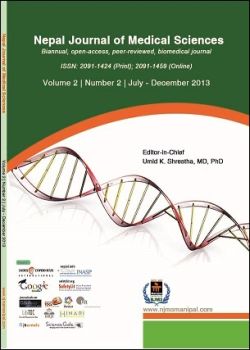Spinal Injuries in a Tertiary Care Referral Center of Western Nepal
DOI:
https://doi.org/10.3126/njms.v2i2.8967Keywords:
Fall injury, Frankel score, spinal injury, vertebral fractureAbstract
Background: Spinal injury is a devastating condition often affecting young and healthy individuals around the world. This devastating injury not only creates enormous physical and emotional cost to individuals but also gives tremendous financial burden to the society. We evaluate the demography, types and causes of the spinal injuries and their management in patients admitted in a hospital.
Methods: Medical records of 45 patients who were presented with spinal injuries in a year were analyzed. The age, sex, mode of injury, sites, types and level of injury, hospital stay, and treatment given were analyzed. Frankel grading was used for the evaluation of the neurological deficits.
Results: The mean age of the patient was 47.5 years (range 19 - 78). Male patients were 60% (n=27) and female 40% (n=18). There were 42.2% (n=19) patients with E grade, 24.4% (n=11) patients with C grade, 20% (n=9) patients with D, three 6.6% (n=3) patients with A and B grades each of patients according to Frankel grade. Lumbar spine was the commonest site of injury. The most common cause of injury was fall, followed by road traffic accidents (RTA) and others. Nineteen patients were treated conservatively, 16 were operated, five patients were referred to other centers due to various reasons and the other five patients were discharged on their request.
Conclusions: Spinal injuries are one of the rapidly growing injuries in our society and the commonest mode of injury was fall. The majority of patients were from the hilly areas.
Nepal Journal of Medical Sciences | Volume 02 | Number 02 | July-December 2013 | Page 156-159
Downloads
Downloads
Published
How to Cite
Issue
Section
License
Copyright © by Nepal Journal of Medical Sciences. The ideas and opinions expressed by authors of articles summarized, quoted, or published in full text in this Journal represents only opinions of authors and do not necessarily reflect the official policy of Nepal Journal of Medical Sciences or the institute with which the author(s) is (are) affiliated, unless so specified.




